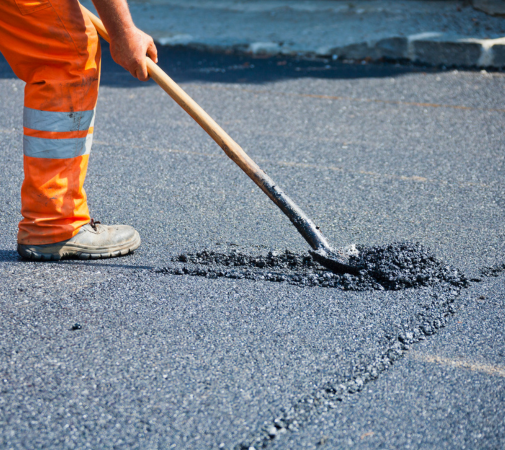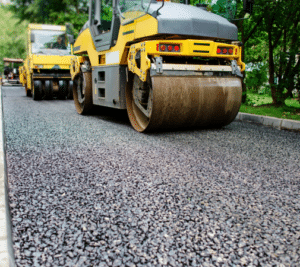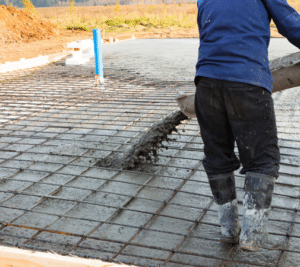Introduction
Asphalt pavements play a vital role in infrastructure, providing a smooth and durable surface for roads, parking lots, and other paved areas. However, these surfaces are subjected to constant wear and tear due to traffic, weather conditions, and other environmental factors. Therefore, it is crucial for property owners and managers to understand the importance of regular maintenance and timely repairs to ensure the longevity and cost-effectiveness of asphalt pavements.
Maintaining asphalt pavements is essential for several reasons. Firstly, it enhances the safety of pedestrians and vehicles by minimizing the risks of accidents caused by potholes, cracks, or uneven surfaces. Well-maintained pavements provide better traction, reducing the chances of skidding or slipping.
Furthermore, timely repairs can significantly extend the lifespan of asphalt pavements and save on long-term costs. Small cracks and potholes, if left unattended, can quickly worsen and lead to more extensive damage, necessitating costly repairs or even complete pavement replacement. By addressing these issues promptly, property owners and managers can prevent further deterioration and avoid the need for more extensive and expensive repairs in the future.
In conclusion, understanding the importance of timely asphalt repair is crucial for property owners and managers. By maintaining asphalt pavements, they can ensure the safety of pedestrians and vehicles, extend the lifespan of the pavement, and save on long-term costs. Investing in proactive repair strategies will ultimately prove to be a wise decision, guaranteeing smooth and cost-effective pavements for years to come.
Understanding Asphalt Damage
Asphalt, a commonly used material for pavement surfaces, is susceptible to various types of damage. Recognizing these common types of damage and their underlying causes is essential for property owners and managers to understand the importance of timely asphalt repair.
One common type of damage is cracks, which develop due to factors such as water infiltration, UV damage, and traffic stress. Water can seep into the asphalt surface through small cracks, causing the underlying layers to weaken and further escalate the damage. UV rays from the sun can also break down the asphalt binder, leading to the formation of cracks. Additionally, constant traffic stress from vehicles can cause the formation and widening of cracks over time.
Another type of damage is potholes, which result from the expansion and contraction of water within the pavement. When cracks are left untreated, water can penetrate the asphalt layers, freeze during colder temperatures, and cause the pavement to break apart, eventually forming potholes.
Rutting is yet another form of damage caused by the constant movement of heavy vehicles over the pavement. Over time, the repetitive stress from traffic causes the asphalt to deform and create depressions or grooves, known as rutting.
It is crucial to address asphalt damage promptly because untreated damage can worsen over time. Cracks will widen, allowing more water infiltration and further weakening the pavement structure. Potholes will grow larger, posing risks to vehicles and pedestrians. Rutting will deepen, affecting the ride quality and stability of the pavement.
By understanding the nature and causes of asphalt damage, property owners and managers can appreciate the importance of proactive repair strategies. Timely asphalt repair not only prevents further damage but also saves on long-term maintenance costs by avoiding more extensive repairs or replacement.
The Benefits of Timely Asphalt Repair
- Prevents Further Damage
Timely asphalt repair is essential in preventing minor issues from becoming major problems. When small cracks or potholes appear on a pavement surface, they may seem insignificant at first. However, if left untreated, these minor issues can worsen over time and lead to significant damage.
By addressing these problems early on, property owners and managers can prevent further damage and prolong the lifespan of their asphalt pavement. Cracks, for instance, provide an entry point for water and other elements that can penetrate the pavement structure and weaken its foundation. This can result in the formation of larger potholes or even structural failure.
Additionally, timely repair work can prevent the spread of damage. Small cracks have the potential to expand and connect, forming larger cracks or potholes. Once this occurs, it becomes more challenging and more expensive to fix the pavement. By promptly repairing small cracks and potholes, property owners and managers can prevent their expansion and save on costly repairs in the future.
Overall, proactive repair strategies that prioritize early intervention can significantly reduce the risk of further damage to asphalt pavements. By addressing minor issues promptly, property owners and managers can maintain safe, functional, and aesthetically pleasing pavements while saving on long-term repair costs.
- Cost Savings
Prompt asphalt repairs can result in significant cost savings in the long run compared to delaying or ignoring repair needs. By promptly addressing small cracks, potholes, and other damage, property owners and managers can prevent these issues from worsening and requiring more extensive and expensive repairs or even complete pavement replacements.
When minor cracks and potholes are left unattended, they can expand under the weight of vehicles and the effects of weather, leading to more significant damage to the pavement structure. The longer these issues are left unresolved, the more costly the repairs become. Delaying repairs may also lead to safety hazards for pedestrians and drivers, potentially resulting in costly legal liabilities.
On the other hand, investing in proactive repair strategies, such as timely crack sealing and filling potholes, can effectively extend the lifespan of the pavement. Regular maintenance and repairs preserve the integrity of the asphalt, preventing the need for complete overhauls.
Furthermore, prompt repairs can minimize the need for disruptive traffic control measures and temporary road closures that accompany more extensive repairs or replacements. This effectively reduces the disruption to businesses and residents located in the affected areas, resulting in cost savings for all stakeholders.
In conclusion, the cost-effectiveness of prompt asphalt repairs is evident. By addressing issues promptly, property owners and managers can save on repair costs, extend the lifespan of the pavement, reduce liability risks, and minimize disruptions. Investing in proactive maintenance strategies is a wise decision that ensures the long-term health and longevity of asphalt surfaces.
- Enhances Safety
Timely asphalt repair plays a crucial role in enhancing safety by preventing accidents and injuries caused by damaged pavement surfaces. When the asphalt pavement begins to deteriorate, it can create various hazards, such as potholes, cracks, and uneven surfaces, which pose significant risks to pedestrians, motorists, and bicyclists.
By promptly addressing these damages through timely repairs, property owners and managers can ensure a safe environment for everyone accessing their premises. Repairing potholes and cracks prevents these imperfections from becoming larger and more dangerous over time. It eliminates tripping hazards for pedestrians and helps maintain a smooth driving surface, reducing the likelihood of accidents.
Moreover, timely asphalt repair helps prevent vehicle skidding or loss of control, minimizing the risk of injuries and vehicle damage. Rigid adherence to proactive repair strategies ensures the longevity of the pavement, reducing the chances of unexpected structural failures that may lead to serious accidents.
Investing in timely asphalt repair not only protects individuals from harm but also safeguards property owners and managers from potential liability issues. By prioritizing safety through regular maintenance and prompt repairs, property owners can create a secure environment that promotes the well-being of all who visit or utilize their facilities.
- Maintains Aesthetic Appeal
Maintaining a well-kept pavement surface is crucial for the overall appearance and perceived value of a property. Aesthetics play a significant role in attracting potential tenants, customers, or buyers. A cracked and deteriorating asphalt surface can give an impression of neglect and lack of attention to detail, which can deter people from visiting or investing in a property.
On the other hand, a smooth and well-maintained pavement surface enhances the curb appeal and creates a positive first impression. It contributes to a visually appealing environment, making visitors feel welcome and comfortable. Aesthetically pleasing pavements can even provide a sense of prestige and professionalism, particularly for businesses and commercial properties.
Moreover, a well-kept pavement surface can also increase the value of a property. When potential buyers or tenants see a property with a visually pleasing and well-maintained pavement, they perceive it as a well-maintained property overall. This perception can lead to increased demand and competition, resulting in higher property values and rental prices.
In summary, maintaining the aesthetic appeal of a pavement surface is crucial for attracting visitors, tenants, customers, or potential buyers and enhancing the perceived value of a property. Investing in timely asphalt repairs is vital for ensuring the longevity and attractiveness of the pavement, which ultimately contributes to the overall success and profitability of a property.
When to Repair: Identifying the Right Time for Asphalt Maintenance
Regular pavement inspection is crucial for identifying the right time for asphalt maintenance. Property owners and managers should follow guidelines for conducting thorough inspections to assess the condition of their asphalt pavement. This includes checking for signs of cracks, potholes, uneven surfaces, or other forms of damage that can affect the functionality and safety of the pavement.
To ensure optimal results, it is essential to perform asphalt repairs during the best seasons and conditions. Generally, it is recommended to conduct asphalt repairs during dry, warm weather when the temperature is above 50 degrees Fahrenheit. This is because hot mix asphalt, used for most repairs, requires warm conditions to properly cure and bond with the existing pavement.
Performing asphalt repairs at the right time is crucial to prevent further deterioration of the pavement and avoid costly repairs down the line. When identified early, small cracks and minor damages can be easily repaired before they turn into larger issues. Postponing repairs or neglecting maintenance leads to the formation of larger cracks, potholes, and other damages that require extensive repair work and expensive treatments.
By following regular inspection guidelines and performing asphalt repairs during the appropriate seasons and conditions, property owners and managers can extend the lifespan of their pavement, ensure its structural integrity, and save cost in the long run.

Repair Techniques and Their Applications
There are several common asphalt repair techniques that property owners and managers can employ to maintain their pavements effectively. Understanding these methods and when to use them is essential in ensuring the longevity and durability of the pavement.
1. Crack filling: Crack filling is a cost-effective repair technique used to seal cracks in the pavement. It involves filling the cracks with specialized materials, preventing water infiltration and further damage. Crack filling is most suitable for minor cracks that have not spread extensively.
2. Patching: Patching is the process of repairing small areas of pavement with deteriorated or damaged sections. It involves removing the damaged area and replacing it with new asphalt. Patching is ideal for localized areas of damage, such as potholes or minor surface deterioration.
3. Overlay: Overlay is a repair technique that involves applying a new layer of asphalt over the existing pavement. It is used when the existing pavement is moderately to severely deteriorated but still structurally sound. Overlay provides a smooth and durable surface, improving both appearance and functionality.
4. Sealcoating: Sealcoating is the process of applying a protective sealant to the pavement surface. It acts as a barrier against UV rays, water, and chemicals, preventing premature deterioration. Sealcoating is recommended for older pavements that show signs of wear and tear, enhancing their appearance and extending their lifespan.
To ensure longer-lasting repairs, it is crucial to use advanced materials and methods. These include the use of high-quality sealants, proper application techniques, and incorporating technologies like infrared patching for more efficient and durable repairs. Investing in advanced techniques and materials not only improves the overall quality and longevity of repairs but also leads to substantial cost savings in the long run.
Conclusion
In conclusion, the significance of timely asphalt repair in pavement maintenance cannot be overstated. By addressing minor issues promptly, property owners and managers can prevent them from escalating into major problems that are expensive to fix and jeopardize the safety of pedestrians and vehicles.
Adopting a proactive approach to pavement maintenance is essential. Regular inspections must be conducted to identify any signs of damage or deterioration, such as cracks, potholes, or uneven surfaces. A proactive mindset encourages property owners and managers to prioritize repairs, allocating resources and budget accordingly.
By investing in timely asphalt repair, property owners and managers can ensure long-lasting, safe, and aesthetically pleasing pavements. The ability to extend the lifespan of the pavement reduces the need for costly and extensive repairs in the future, ultimately saving money and resources. Furthermore, well-maintained pavements contribute to an inviting and professional image, enhancing the overall appeal of the property.
Ultimately, embracing timely asphalt repair as an integral part of pavement maintenance leads to numerous long-term benefits. It improves the safety and usability of the pavement, saves money on future repairs, and enhances the appearance and value of the property. By prioritizing proactive strategies, property owners and managers can successfully maintain their pavements for years to come.



